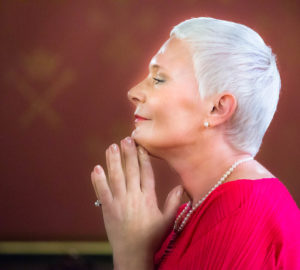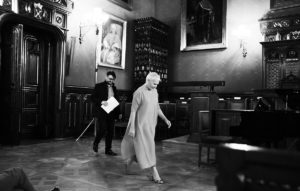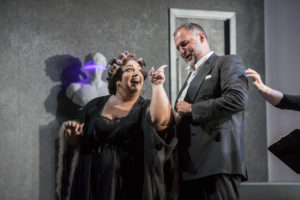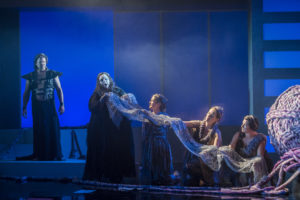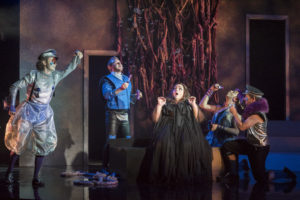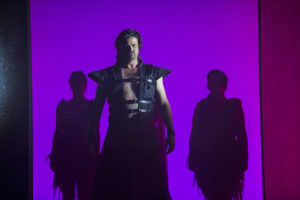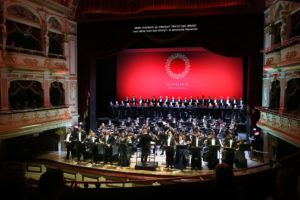Niewiarygodne, ile to już lat minęło. W najbliższą środę, 11 lipca, rozpoczyna się czterdziesty, jubileuszowy Festiwal w Starym Sączu. Dwa dni później w Kinie Sokół odbędzie się konferencja „Wszystkie dobrodziejstwa czterdziestu Starosądeckich Festiwali Muzyki Dawnej”. W pierwszej części wystąpią kolejni dyrektorzy artystyczni imprezy: Stanisław Gałoński, Marcin Bornus-Szczyciński, Antoni Pilch, Stanisław Welanyk, Antoni Citak i Marcin Szelest. W drugiej podyskutujemy o ewolucji wykonawstwa historycznego – w gronie rozmówców Piotra Matwiejczuka, moderatora konferencji, znajdą się Ewa Obniska, Dorota Szwarcman, Marek Dyżewski i niżej podpisana. Która od czynnego zainteresowania muzyką dawną do tego, co robi teraz, przeszła dość długą drogę, o czym w poniższym tekście, opublikowanym w książce Wszystkie dobrodziejstwa – poświęconej historii starosądeckiej imprezy.
***
Był rok 1992. Tempo przemian w moim życiu osobistym i zawodowym dorównywało prędkości gwałtownej transformacji ustrojowej i przeobrażeń społeczno-kulturowych w całym kraju. Zdążyłam się już znudzić pierwszą stałą pracą po studiach i dojść do wniosku, że najwyższy czas postawić wszystko na jedną kartę – rozwinąć działalność zespołu Studio 600, który zaczynał jeszcze w PRL, jako Zespół Chorałowy Ars Nova przy ansamblu prowadzonym przez Jacka Urbaniaka, i niedługo potem wybił się na niepodległość. Pod tajemniczo brzmiącą nazwą, którą – teraz mogę już zdradzić – pożyczyłyśmy od nazwy handlowej okapu kuchennego w mieszkaniu, gdzie odbywały się nasze próby; w stałym, pięcioosobowym składzie, w którym znalazła się także Dorota Szwarcman, ówczesna dziennikarka muzyczna „Gazety Wyborczej”; i pod dwuosobowym kierownictwem, moim i Aldony Czechak, prywatnie żony Tadeusza, długoletniego lutnisty Ars Nova, a w nieodległej przyszłości założyciela i szefa zespołu Dekameron.
W tej zwariowanej epoce prowadziłyśmy dość ożywioną działalność koncertową, czegoś nam jednak brakowało. Miałyśmy coraz dobitniejsze poczucie, że nie wystarczy iść ścieżką wydeptaną przez zachodnich pionierów muzyki dawnej i bezmyślnie naśladować ich interpretacje. Ewa Obniska, z którą współpracowałam od kilku lat w Programie 2 PR, podsunęła nam myśl przygotowania programu sekwencji i antyfon Hildegardy von Bingen, mistyczki i reformatorki religijnej z XII wieku, jednej z pierwszych znanych z imienia kompozytorek w świecie zachodnim. Zabrałyśmy się do pracy z zapałem, pod czujną opieką księdza profesora Jerzego Pikulika, wciąż jednak w przeświadczeniu, że błądzimy we mgle. W moim przypadku tym głębszym, że dałam się właśnie porwać rewolucji, jaką w śpiewie chorałowym wszczął Marcel Pérès, nie wspominając o fascynacji projektem zespołu Sequentia, który już w 1982 roku postanowił opracować i nagrać dzieła wszystkie frankońskiej mniszki. Na sam dźwięk nazwiska „Pérès” ksiądz Jerzy żegnał się szerokim znakiem krzyża, o usłyszeniu Sequentii na żywo w siermiężnym PRL-u mogłyśmy sobie tylko pomarzyć.

Studio 600 na Festiwalu w 1992 roku. Od lewej Dorota Szwarcman, Joanna Walma, Aleksandra Zduńska, Aldona Czechak i Dorota Kozińska. Fot. Stanisław Śmierciak.
Do czasu, aż wybuchła wolność i nagle wszystko zdało się możliwe. W maju 1992, za pożyczone od brata sto czeskich koron, pojechałam do Pragi na koncert Ensemble Organum pod dyrekcją Marcela Pérèsa, przedstawiłam mu się po występie i dwa tygodnie później dostałam zaproszenie na kurs mistrzowski. Z całym zespołem. Zebranie funduszy na piekielnie drogi wyjazd do Francji zajęło mi niecały miesiąc. Nie nastała jeszcze epoka żmudnych procedur ubiegania się o dotacje i granty – wystarczyło pójść do ministerstwa i kilku fundacji z wystukaną na maszynie do pisania prośbą o dofinansowanie, wykazać się dostateczną determinacją i obgadać sprawę z paroma naprawdę kompetentnymi decydentami. Kurs miał odbyć się w sierpniu. Nagle stanęłyśmy przed dylematem nadmiaru: na początku roku Studio 600 dostało inną propozycję nie do odrzucenia – udziału w reaktywowanym po rocznej przerwie, pod nowym kierownictwem Marcina Bornusa-Szczycińskiego, Starosądeckim Festiwalu Muzyki Dawnej. Oczywiście z programem poświęconym twórczości Hildegardy. Jechać? Oczywiście, że jechać. Zewrzemy szyki, ośpiewamy się przed kursem, uskrzydlone perspektywą niedługiego spotkania z największym ówczesnym obrazoburcą wykonawstwa historycznego. A jak dobrze pójdzie – w co wciąż nie mogłam uwierzyć – wystąpimy na Festiwalu bok w bok z uwielbianą Sequentią. Trochę strach, trochę wstyd z powodu własnej niewiedzy, ale któż by przepuścił taką okazję?
Z przygotowań do tamtego Festiwalu pamiętam przede wszystkim atmosferę niepewności, ogólnego zamieszania i spontanicznie zawiązanej wspólnoty. Jeszcze na sześć tygodni przed imprezą nie było do końca wiadomo, czy dojdzie do skutku. Gdyby nie ofiarne działania Polskiego Towarzystwa Muzyki Dawnej, życzliwość władz i zapał większości muzyków, którzy zdecydowali się grać i śpiewać za darmo, półdarmo, a czasem nawet dokładając swoje trzy grosze do interesu, inicjatywa wzięłaby w łeb. To właśnie w Starym Sączu zrodził się pomysł swoistego współuczestnictwa muzyków i słuchaczy, kontynuowany po dziś dzień na Festiwalu „Pieśń Naszych Korzeni” w pobliskim Jarosławiu. Miasto oddało nam do dyspozycji postpeerelowski ośrodek wypoczynkowy, który na cztery dni zmienił się w radosną wioskę muzycznej rozpusty. Władze kościelne namówiły wykonawców do czynnego udziału w liturgii. Po koncertach muzycy – ramię w ramię ze słuchaczami – przechodzili do klubu festiwalowego, urządzonego w jednej ze staromiejskich restauracji. Jedliśmy i piliśmy jak za króla Sasa, śpiewaliśmy i graliśmy, dopóki obsługa nie wyrzucała nas z lokalu, imprezy kontynuowaliśmy pod gołym niebem, przy ogniskach między domkami kempingowymi nad Popradem. Nazajutrz, jak gdyby nigdy nic, stawialiśmy się do roboty w kościele farnym albo u Sióstr Klarysek.
Pięknie było, choć trudno. Po raz pierwszy usłyszałam na żywo nie tylko Sequentię, ale też estoński zespół Linnamuusikud. Po raz pierwszy zdałam sobie sprawę, że współpraca z władzami kościelnymi wymaga ustępstw, które często wykraczały poza dotychczasowe ramy wolności artystycznej. Po raz pierwszy nabrałam wątpliwości, gdzie przebiega cienka granica między sacrum a profanum. Paradoksalnie najgłębiej zapadła mi w pamięć sytuacja nieledwie intymna: po koncercie Sequentii, w klubie festiwalowym, o drugiej nad ranem, kiedy Barbara Thornton i Benjamin Bagby wstali od stołu, ujęli się delikatnie za ręce i najczulej – jak para średniowiecznych kochanków – zaśpiewali Ach, senliches Leiden. Moją ukochaną pieśń Oswalda von Wolkensteina, którą do tamtej pory znałam tylko z interpretacji Studia der Frühen Musik pod dyrekcją Thomasa Binkleya. Posłuchałam, wpadłam w zachwyt i podziękowałam losowi, że zetknął mnie z parą artystów niezwykłych, którzy byli na tyle uprzejmi, żeby nie wyśmiać naszych wczorajszych prób zmierzenia się z dziełem Hildegardy von Bingen. Ba, nawet je pochwalili.

Autorka z Barbarą Thornton w Starym Sączu w 1994 roku.
Minęły dwa lata, chyba najbardziej owocne w historii Studia 600. Kurs mistrzowski u Pérèsa całkowicie odmienił nasz stosunek do wykonawstwa muzyki dawnej. Przeistoczył go z odtwórczego w uczestniczący, skłonił do badań źródłowych, pracy na rękopisach, studiów porównawczych nad tradycjami wokalnymi, rozwijania umiejętności świadomej improwizacji. Przygotowałyśmy materiał na pierwszą autorską płytę z francuskim chorałem barokowym, opracowaną według najbardziej wyśrubowanych standardów zachodnich, wydaną przez prestiżową wytwórnię CD Accord, nominowaną do Nagrody Muzycznej Fryderyk. Minęły dwa lata, chyba najbardziej znamienne w mojej karierze zawodowej. Weszłam w skład zespołu redakcyjnego „Ruchu Muzycznego”, zaczęłam prowadzić dział krajowy, w miarę harmonijnie – tak mi się przynajmniej wydawało – łączyłam działalność recenzencką z pracą artystyczną. W 1994 roku pojechałam znów do Starego Sącza, tym razem wyłącznie jako krytyk.
Wysiadłam z pociągu, podreptałam w stronę ośrodka wypoczynkowego nad Popradem i nagle rozpoznałam na swojej drodze dwie znajome postaci. Zanim zdążyłam się odezwać, Barbara Thornton zamachała ręką i wykrzyknęła radośnie: „Hi Dorota, how are you doing?”. Jeszcze tego samego wieczoru dostałam zaproszenie do uczestnictwa w legendarnym programie Sequentii, poświęconym badaniom nad twórczością Hildegardy von Bingen. Nie wierzyłam własnym uszom – aż do chwili, kiedy wyszło na jaw, że Barbara i Benjamin naprawdę wolą spędzać czas w naszej kompanii przy ognisku niż w klubie festiwalowym. Bo impreza zaczęła skręcać w niebezpieczną stronę: publiczność składała się niemal wyłącznie z członków zaprzyjaźnionych organizacji, uczniów autorskich klas szkół muzycznych, zakonników i młodzieży z duszpasterstw dominikańskich. Tak zwani „zwykli” słuchacze dostali do dyspozycji niespełna trzydzieści miejsc, krytyka ogólnopolska nie okazała zainteresowania festiwalem. A przecież właśnie wtedy Sequentia wystąpiła w brawurowym programie złożonym z lamentacji średniowiecznych, właśnie wtedy mogliśmy usłyszeć Ensemble Gilles Binchois u szczytu ich formy, wtedy największe triumfy święciła berlińska Musikalische Compagney. Tamte dni w Starym Sączu opisałam ze smutkiem jako „Festiwal do użytku wewnętrznego”. Nie mogłam przeboleć, że takie skarby skrywa się przed ludźmi spragnionymi i nieświadomymi prawdziwego piękna muzyki dawnej. Zwątpiłam w swą krytyczną zdolność przekonywania. Postanowiłam oddać pierwszeństwo drzemiącej we mnie badaczce i wykonawczyni.
Przez następne lata kursowałam między Kolonią, Antwerpią, Frankfurtem a Warszawą, co kilka miesięcy uczestnicząc w intensywnych sesjach prac nad dziełem Hildegardy. Ku nieskrywanej ciekawości, a czasem konsternacji współpasażerów zakuwałam sekwencje Hildegardy na pamięć w samolotach i pociągach. Poznałam kilka obiecujących artystek, które z czasem stworzyły własne zespoły i dzielą się ówczesnymi doświadczeniami z najmłodszym pokoleniem entuzjastów wykonawstwa historycznego. Dałyśmy kilka koncertów w Niemczech i w Belgii. Radość i entuzjazm wkrótce przerodziły się w żałobę. Barbara odeszła w 1998 roku, po długiej walce z nieoperacyjnym rakiem mózgu. Pozostałe uczestniczki projektu skupiły się na własnych przedsięwzięciach. Ja oddałam się prawie bez reszty pracy krytyka i redaktora. Studio 600 przestało opracowywać nowe programy koncertów.
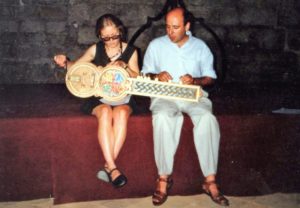
Z Marcelem Pérèsem na kursie mistrzowskim interpretacji organum w Royaumont, 1995.
Przełom nastąpił w 1999 roku. Nasz zespół znów dostał zaproszenie od Starosądeckiego Festiwalu Muzyki Dawnej, już pod kierunkiem Stanisława Welanyka. Historia zatoczyła koło, aczkolwiek boleśnie niepełne. Studio 600 dało koncert złożony z utworów Hildegardy von Bingen – bogatsze o siedem lat doświadczeń wspólnego śpiewania w tym samym składzie, bogatsze o wiedzę, którą zawdzięczałam studiom u Barbary Thornton. Krytycy nie szczędzili nam później pochwał, podobnie jak owdowiały Benjamin Bagby, który przysłuchiwał się naszym poczynaniom z pierwszego rzędu siedzeń w kościele św. Elżbiety. Mnie wryło się w pamięć własne, solowe wykonanie hymnu Ave generosa. Dopracowane w najdrobniejszych szczegółach, przemyślane do głębi – i rozpaczliwie ostatnie. Śpiewałam, dawałam z siebie wszystko, patrzyłam Bagby’emu prosto w oczy i powoli do mnie docierało, że jako wykonawczyni nie mam już nic więcej do powiedzenia. Kiedy zeszłyśmy z estrady i oświadczyłam reszcie zespołu, że kończymy działalność, nikt nie zaprotestował. Zostawiłyśmy po sobie dobre wspomnienia. Nie usunęłyśmy się w cień. Od tamtej pory, każda na swój sposób, uczymy ludzi kochać muzykę. Ja właśnie wtedy zdałam sobie sprawę, że moim prawdziwym powołaniem jest krytyka.
W Starym Sączu postanowiłam zostać artystką. W Starym Sączu postanowiłam nią nie być. W moim końcu był mój początek. Obydwie decyzje okazały się najlepszymi w moim życiu.


